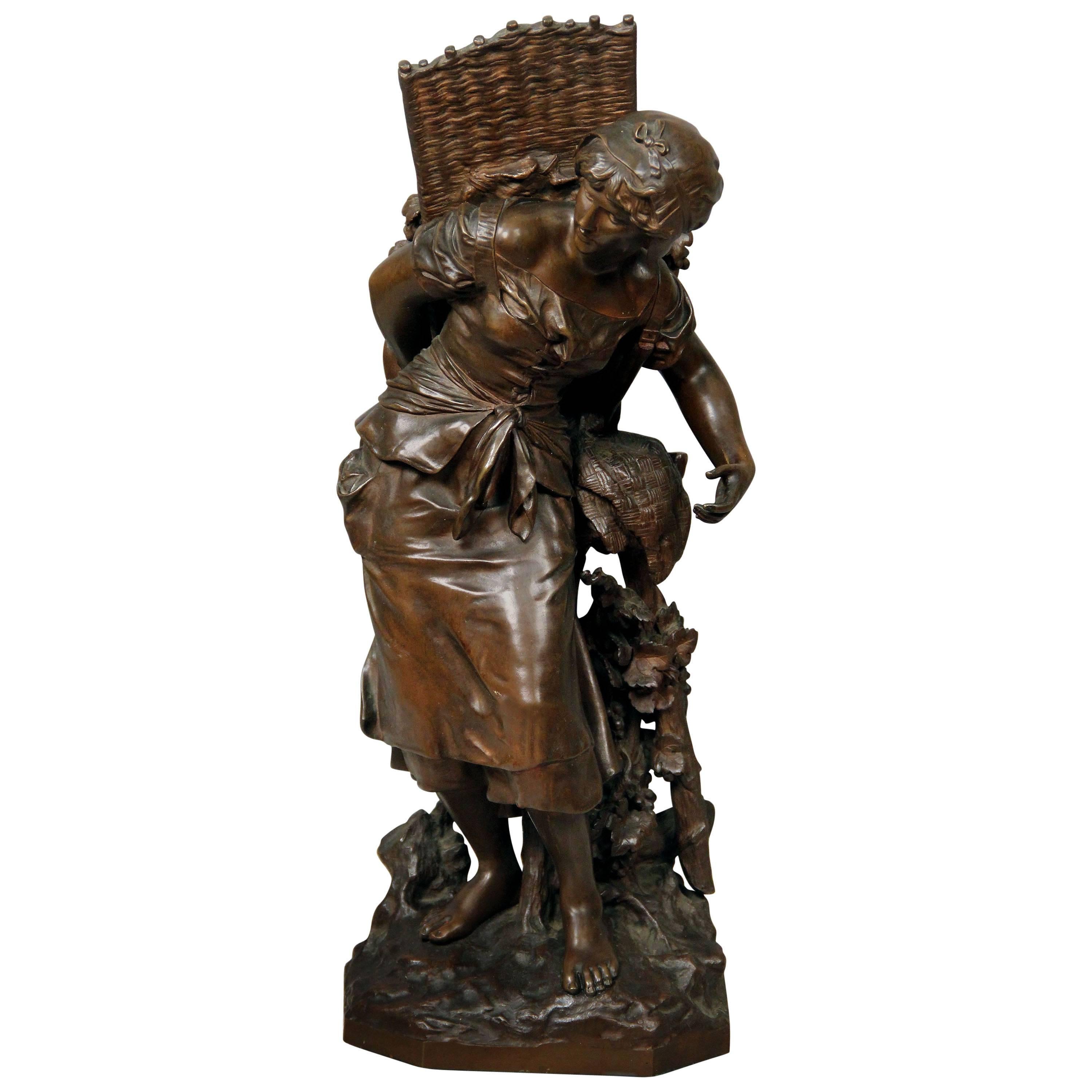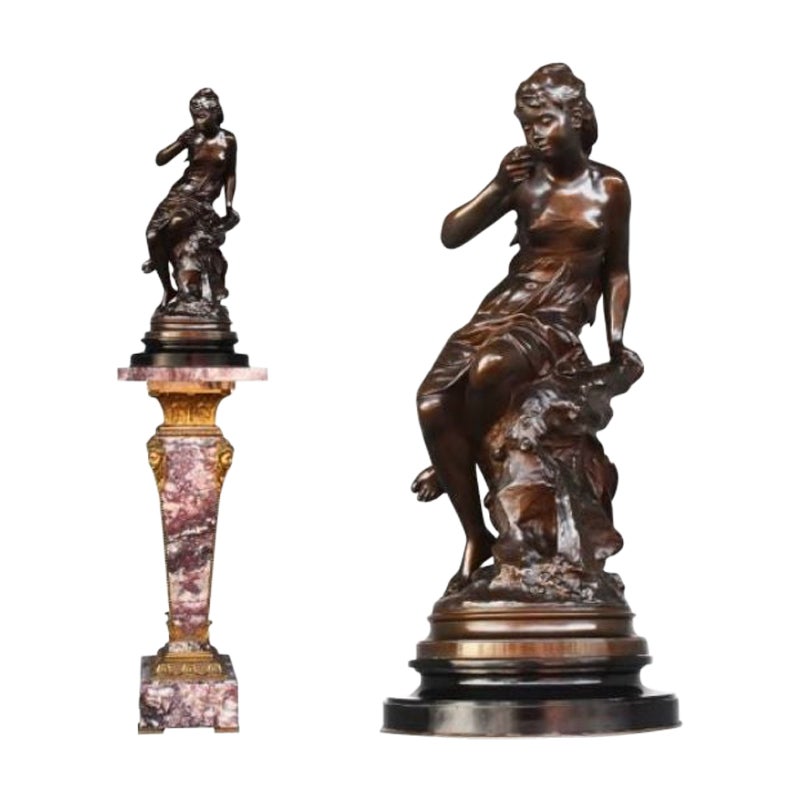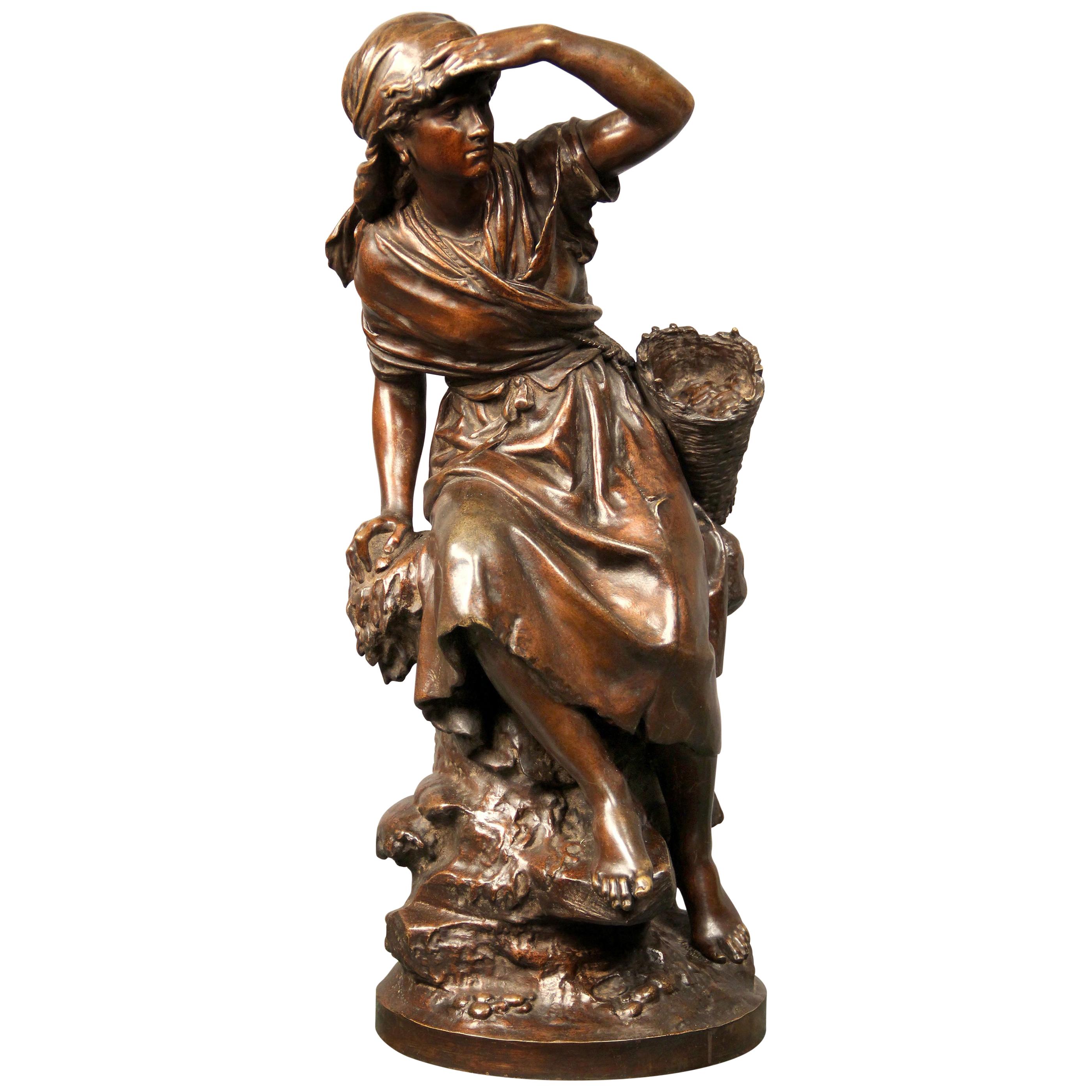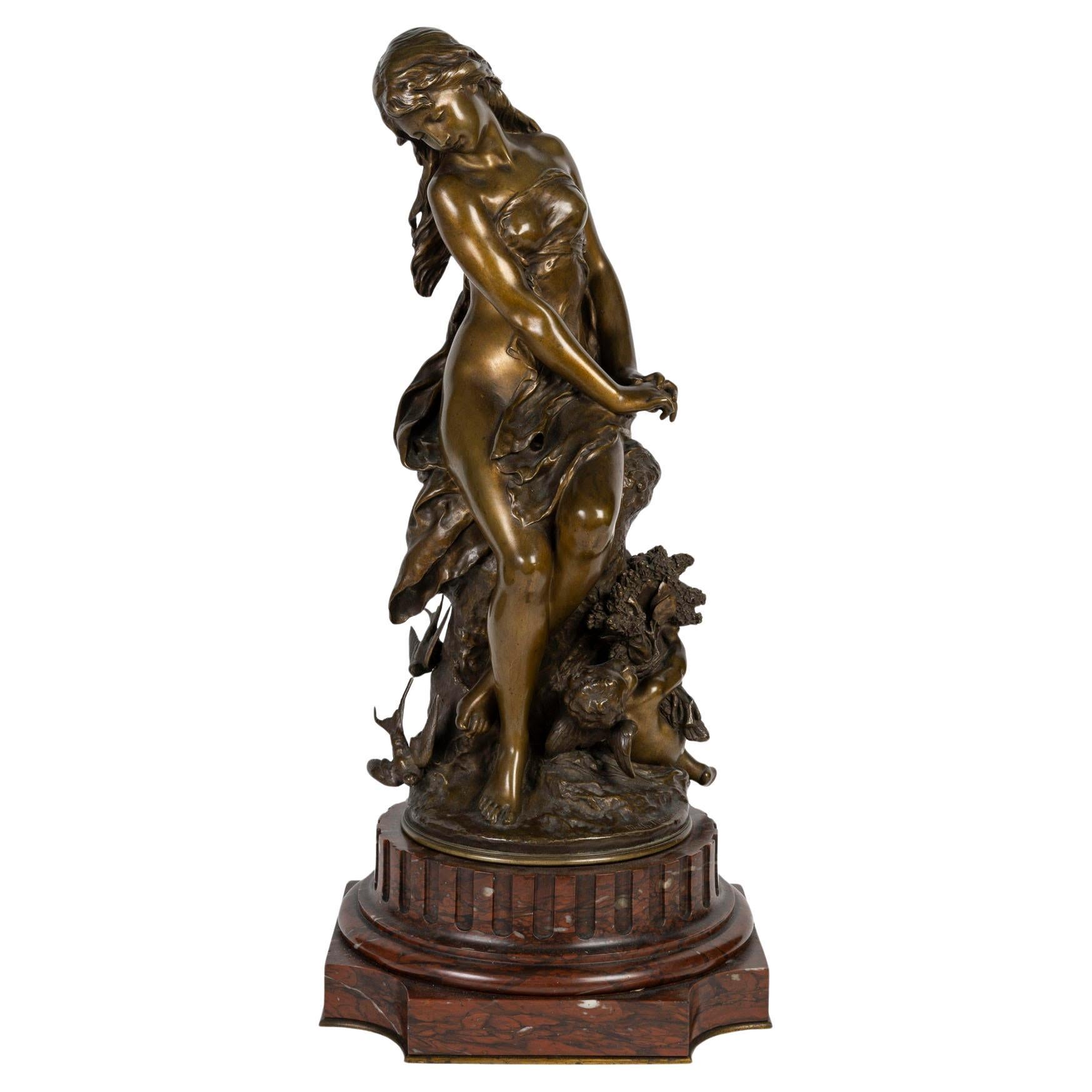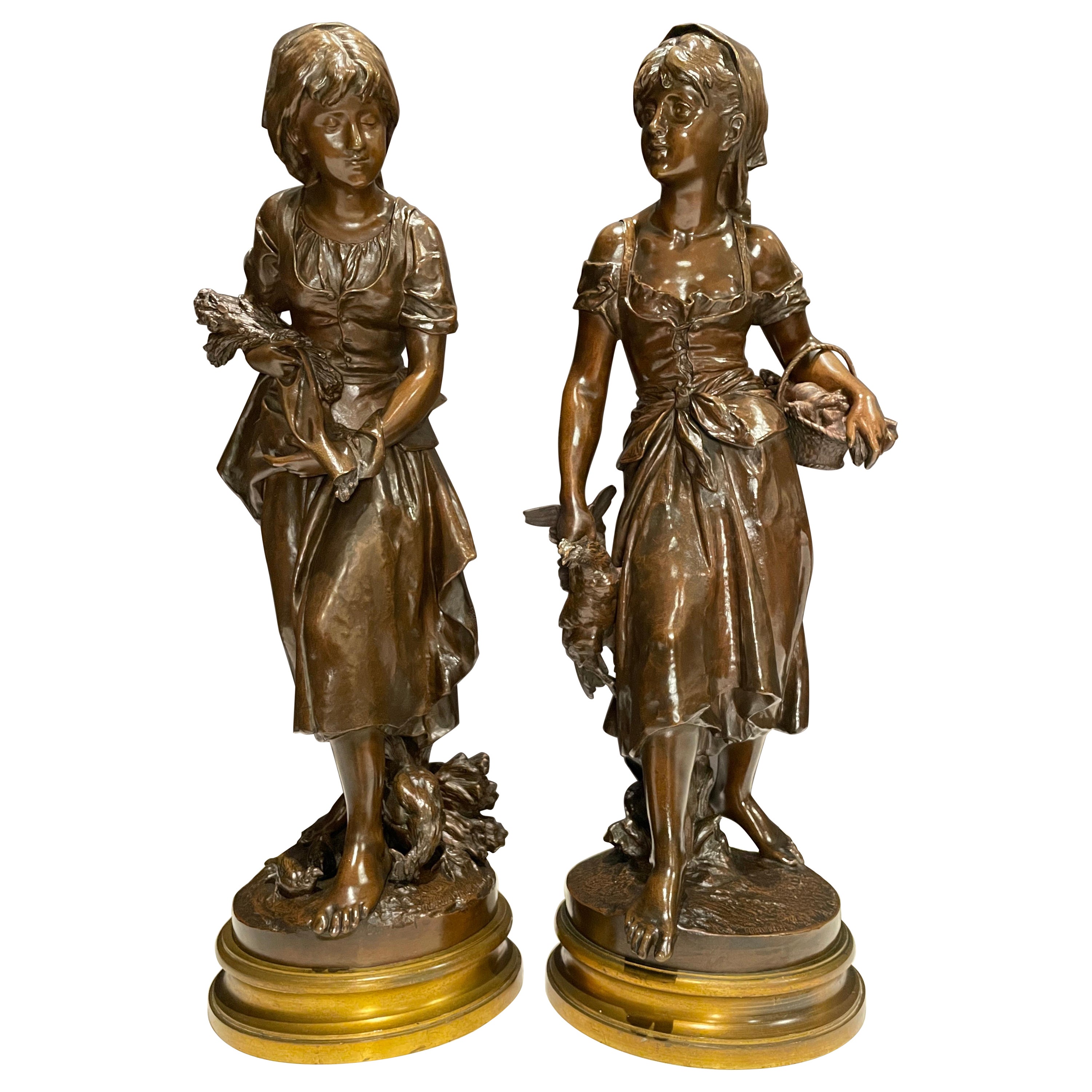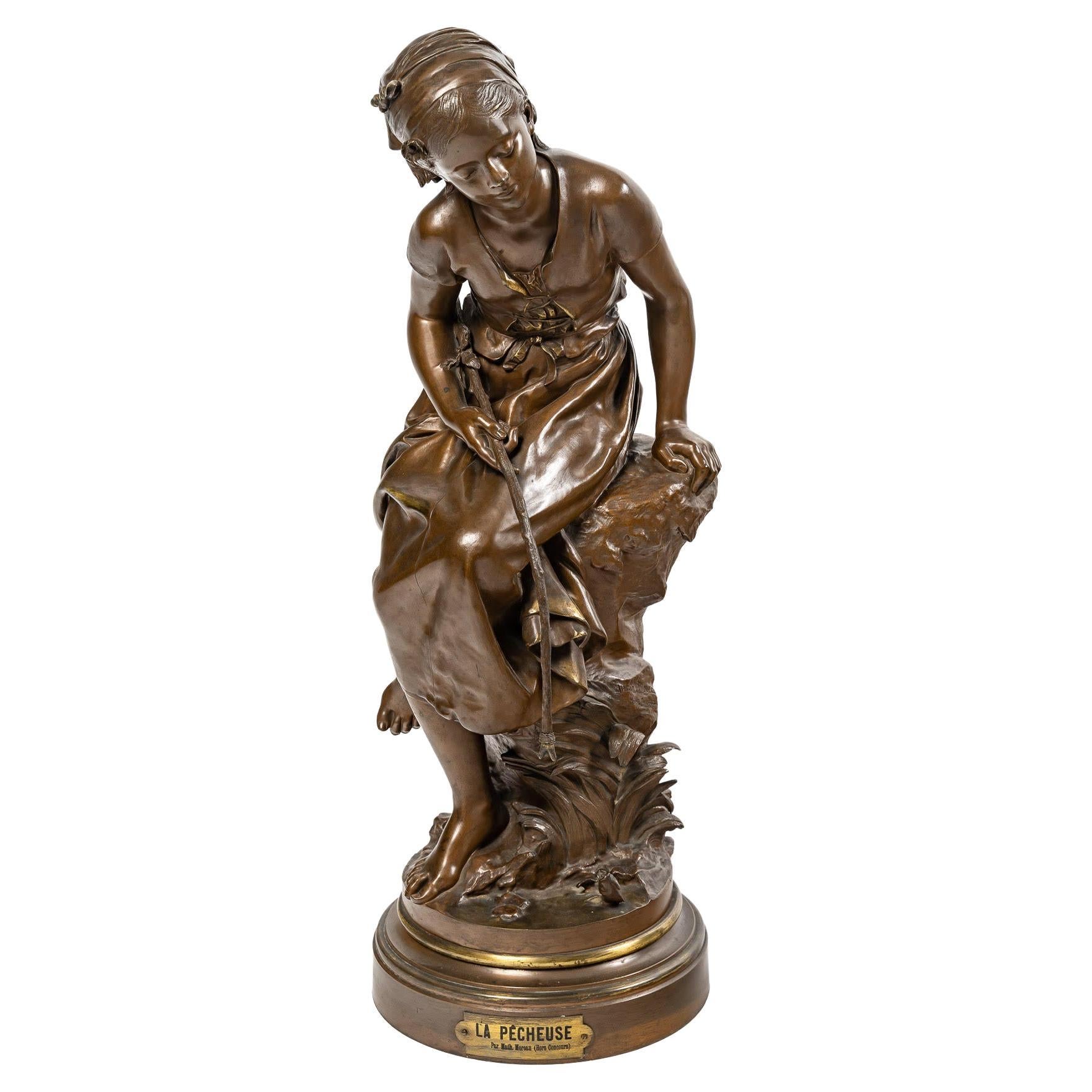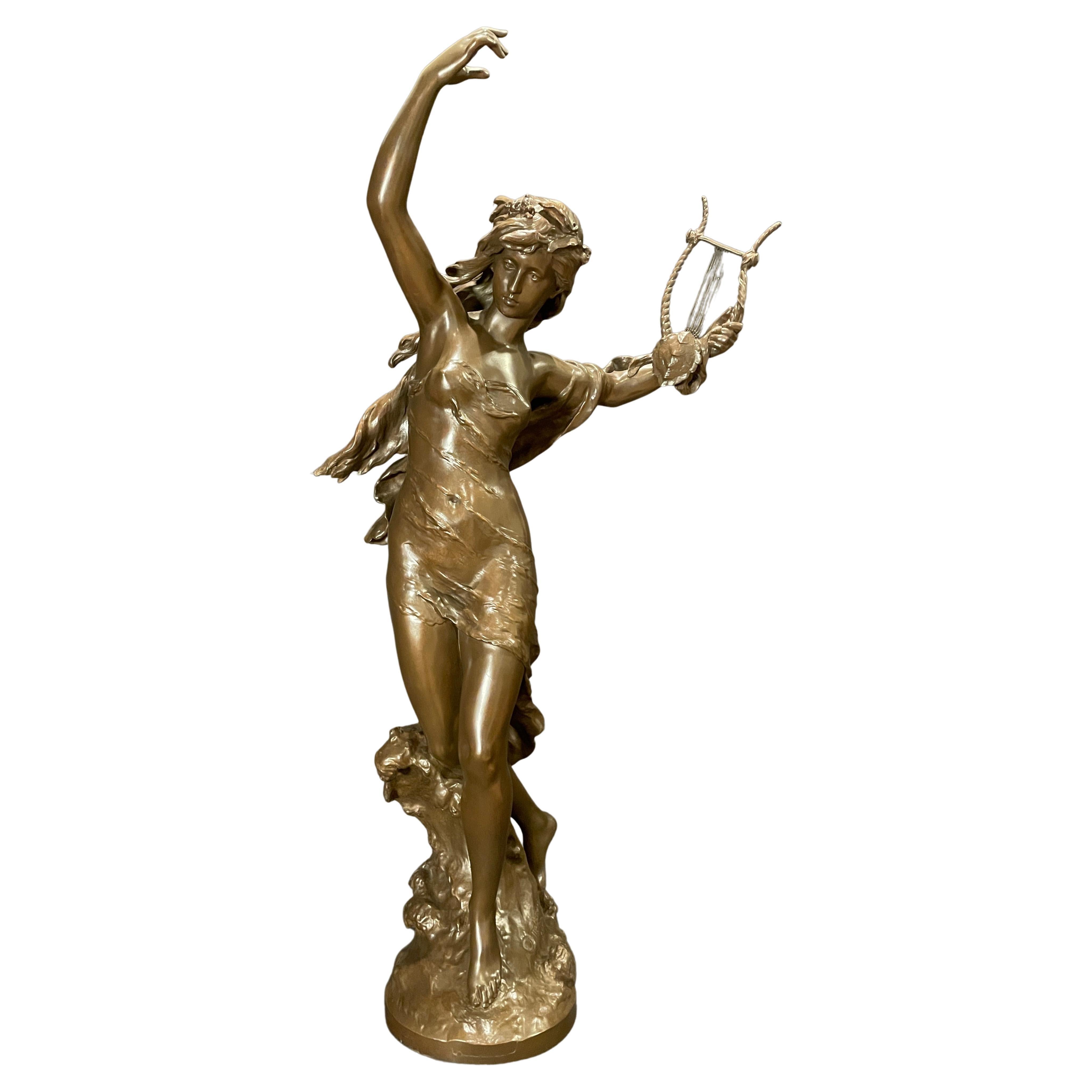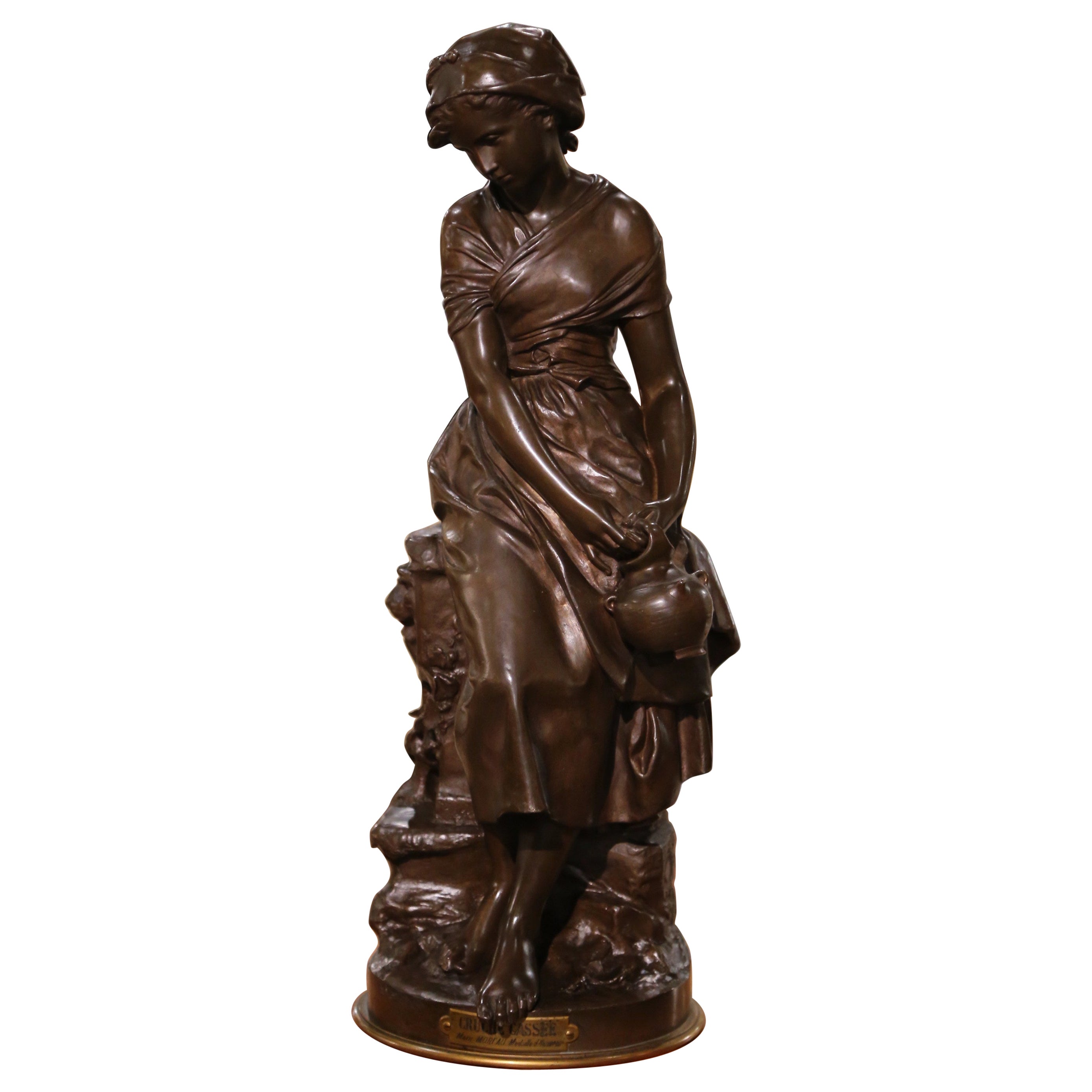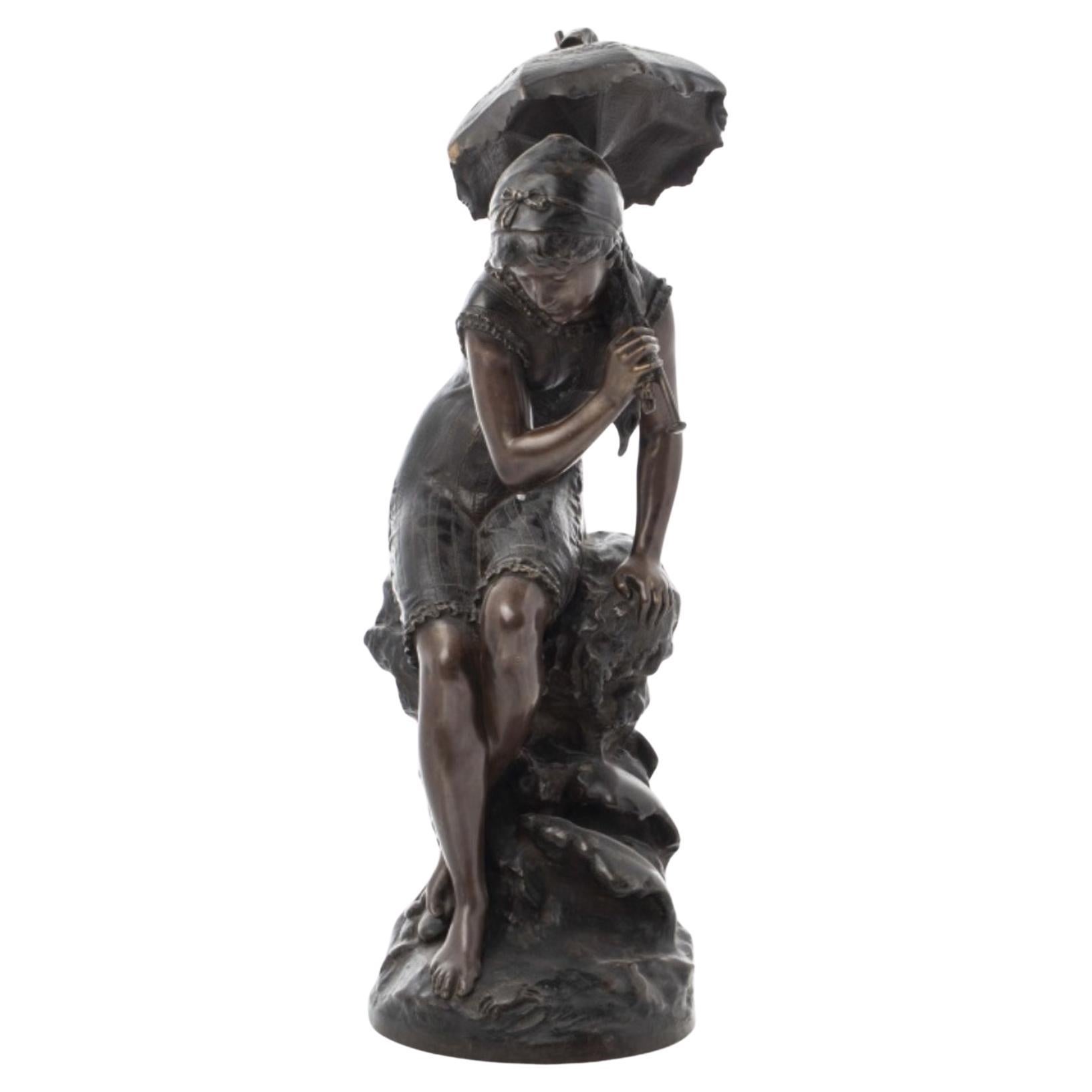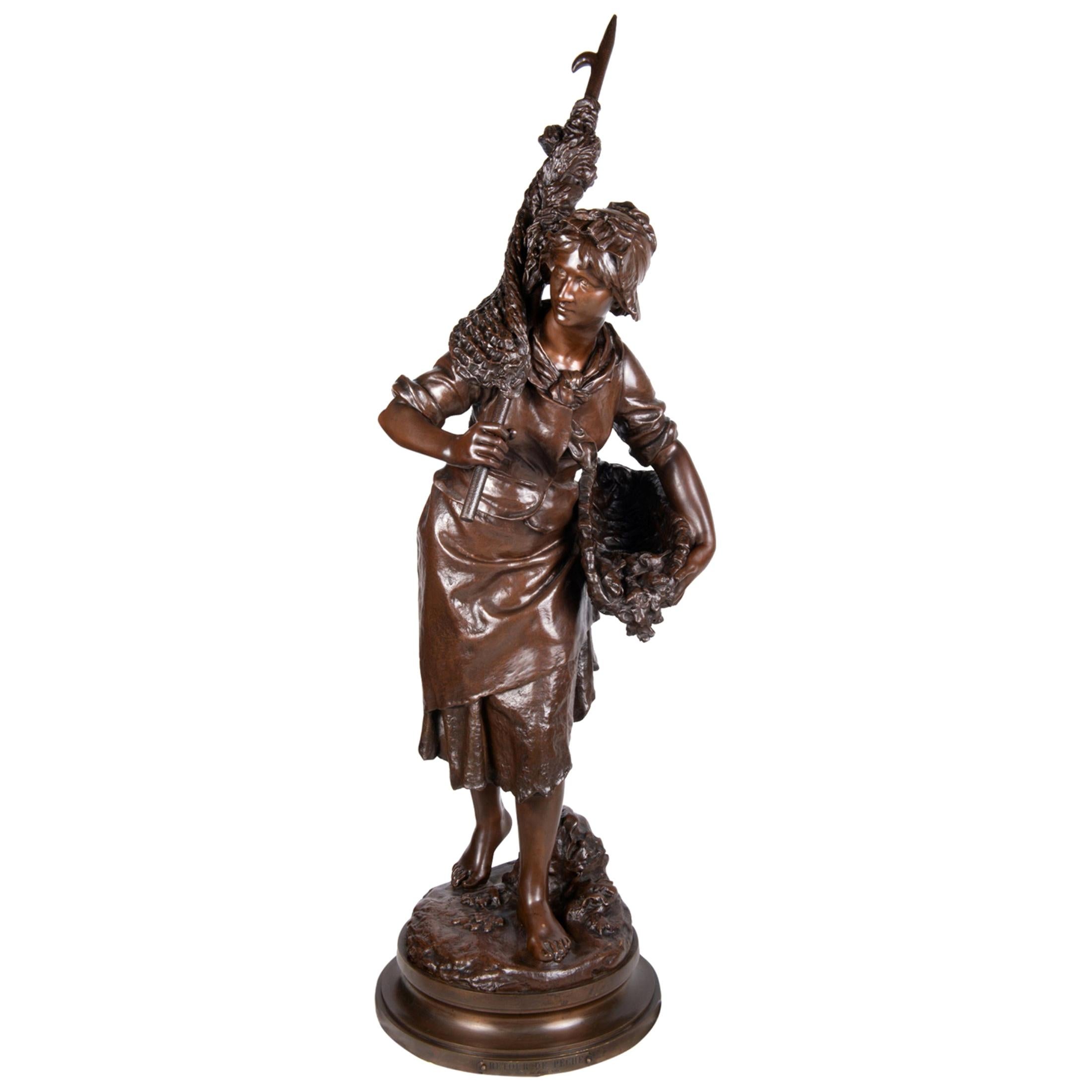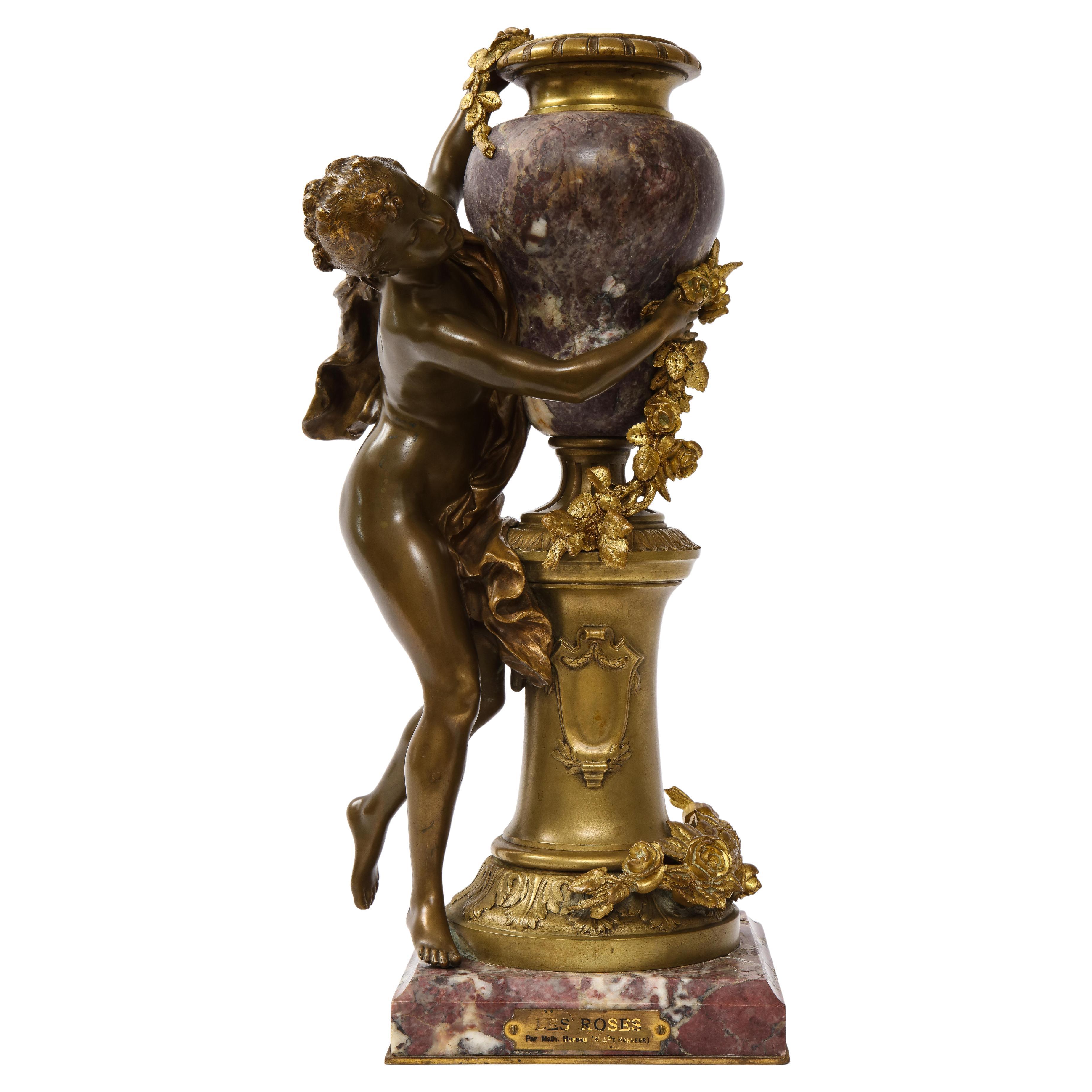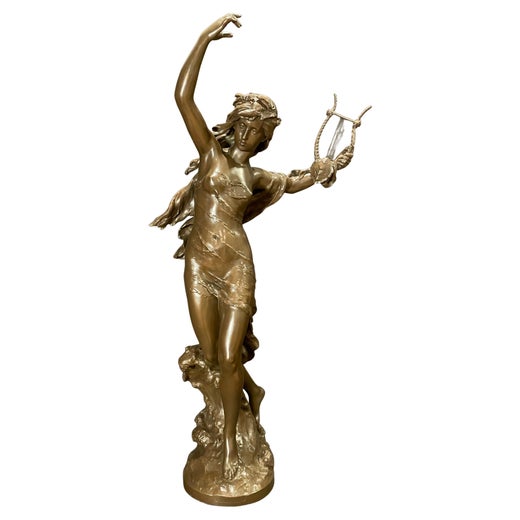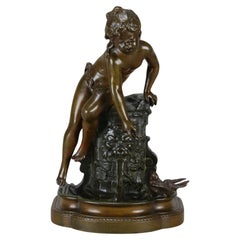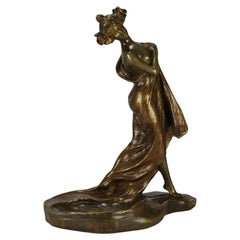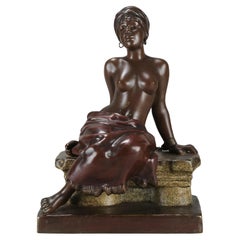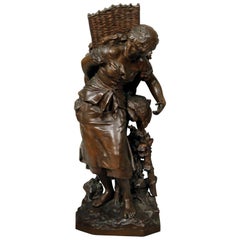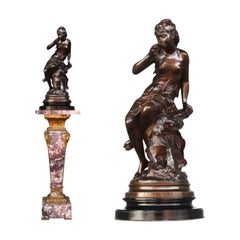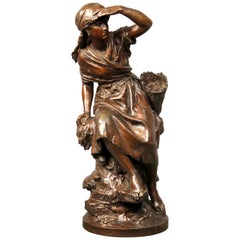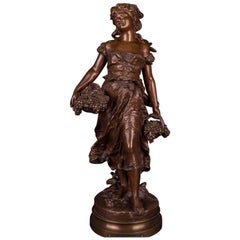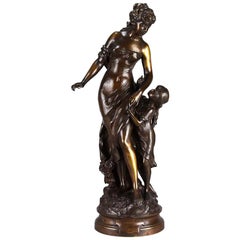
Late 19th Century Art Nouveau Bronze “La Reconnaissance” by Mathurin Moreau
View Similar Items
Want more images or videos?
Request additional images or videos from the seller
1 of 11
Late 19th Century Art Nouveau Bronze “La Reconnaissance” by Mathurin Moreau
About the Item
- Creator:Mathurin Moreau (Sculptor)
- Dimensions:Height: 23.23 in (59 cm)Width: 0 in (0.01 mm)Depth: 0 in (0.01 mm)
- Style:Art Nouveau (Of the Period)
- Materials and Techniques:Bronze,Cast
- Place of Origin:
- Period:
- Date of Manufacture:1898
- Condition:Wear consistent with age and use. Excellent. Excellent Please note that our items are genuine antiques with considerable age. It is therefore normal that they will show some signs of wear and handling to the surface. This change to the surface is known as patina and confirms the age.
- Seller Location:London, GB
- Reference Number:Seller: SKU 79861stDibs: LU3216313258851
Mathurin Moreau
Mathurin Moreau was a renowned French sculptor born on November 18, 1822, in Dijon, France, into a family of artists. He was the son of sculptor Jean-Baptiste Moreau and the brother of sculptors Hippolyte and Auguste Moreau, thus part of a dynasty that significantly influenced French sculpture in the 19th century. Educated at the École des Beaux-Arts under the tutelage of Étienne-Jules Ramey and Augustin-Alexandre Dumont, Moreau went on to become a prominent figure in the French art scene. He was known for his exceptional skills in crafting bronze sculptures, which are among the most celebrated aspects of his artistic legacy. Moreau debuted at the Salon in 1848 and rapidly gained acclaim. His works often depicted allegorical figures, mythological scenes, and typical rural life, capturing both the idealistic beauty and the detailed realism that were hallmarks of the period's sculpture. Many of his bronzes were cast by the famous Val d'Osne foundry, which helped ensure the high quality of his pieces. The foundry was known for its superb craftsmanship and was one of the primary mediums for Moreau’s creations. Throughout his career, Mathurin Moreau received numerous awards, including a medal of honor at the Exposition Universelle in 1878. He was also made a Knight of the Legion of Honor in 1865 and rose to become an officer of the order in 1885. His artworks were not only celebrated in France but also internationally, as his bronzes found homes in diverse locations, from Parisian squares to foreign collections. Moreau's works are characterized by their classical style, attention to detail, and the expressive beauty of their subjects. Some of his notable bronze sculptures include allegorical representations such as "La Danse" and "L’Eau". These pieces exemplify his ability to translate ethereal themes into tangible beauty, making his sculptures highly sought after by collectors and museums worldwide. Mathurin Moreau passed away in 1912, leaving behind a rich legacy of artistic achievement that continues to be celebrated and revered in the art world today. His sculptures, especially his bronzes, remain valuable for their artistic and historical significance, often fetching high prices at auctions and retaining a place of prominence in collections of 19th-century French art.
About the Seller
5.0
Gold Seller
Premium sellers maintaining a 4.3+ rating and 24-hour response times
Established in 1936
1stDibs seller since 2017
75 sales on 1stDibs
Typical response time: 3 hours
Authenticity Guarantee
In the unlikely event there’s an issue with an item’s authenticity, contact us within 1 year for a full refund. DetailsMoney-Back Guarantee
If your item is not as described, is damaged in transit, or does not arrive, contact us within 7 days for a full refund. Details24-Hour Cancellation
You have a 24-hour grace period in which to reconsider your purchase, with no questions asked.Vetted Professional Sellers
Our world-class sellers must adhere to strict standards for service and quality, maintaining the integrity of our listings.Price-Match Guarantee
If you find that a seller listed the same item for a lower price elsewhere, we’ll match it.Trusted Global Delivery
Our best-in-class carrier network provides specialized shipping options worldwide, including custom delivery.More From This Seller
View All19th Century Art Nouveau Bronze Sculpture "Fille au Puits" by Auguste Moreau
By Auguste Moreau
Located in London, GB
A very fine late 19th Century Art Nouveau bronze figure of a young girl sat upon a well feeding a small bird, exhibting excellent rich brown variegated patina and very fine hand fini...
Category
Antique Late 19th Century French Art Nouveau Figurative Sculptures
Materials
Bronze
Late 19th Century Art Nouveau Bronze "Nouveau Lady" by Georges Van Der Straeten
By Georges Van der Straeten
Located in London, GB
A delightful Art Nouveau Bronze figure of a young beauty scantily dressed with only a shawl draped across her body in a striking pose. The surface of the bronze with rich golden/brow...
Category
Antique Late 19th Century Belgian Art Nouveau Figurative Sculptures
Materials
Bronze
Late 19th Century Art Nouveau Bronze figure "Slave Girl" by Emmanuel Villanis
By Emmanuel Villanis
Located in London, GB
A beautiful patinated Art Nouveau bronze study of a young Art Nouveau beauty sat upon a wall wearing chains with excellent variegated rich brown patina and excellent hand chased surf...
Category
Antique Late 19th Century French Art Nouveau Figurative Sculptures
Materials
Bronze
Late 19th Century Art Nouveau Bronze Entitled "Broken Jug" by Charles Anfrie
By Charles Anfrie
Located in London, GB
A very fine late 19th century bronze figure of a young lad dressed in period attire holding a broken jug, with excellent rich brown patina and fabulous hand finished surface detail, signed & titled
ADDITIONAL INFORMATION
Height: 20 cm
Condition: excellent original condition
Circa: 1890
Materials: Bronze
SKU: 8279
ABOUT
Charles Anfrie...
Category
Antique 1890s French Art Nouveau Figurative Sculptures
Materials
Bronze
Late 19th Century Art Nouveau French Bronze entitled "Boy and Girl"
Located in London, GB
A charming pair of late 19th Century bronze studies of a two young children one holding a bowl whilst the other holds a bird with excellent hand chased surface detail and very fine r...
Category
Antique Late 19th Century French Art Nouveau Figurative Sculptures
Materials
Bronze
Late 19th Century Art Nouveau Sculpture "Venus de Milo" by F. Barbedienne
By F. Barbedienne Foundry
Located in London, GB
A large and impressive late 19th Century bronze study of the famous Venus de Milo sculpture of antiquity with excellent rich brown patina and good hand finished surface detail, inscribed F.Barbedienne foundry
ADDITIONAL INFORMATION
Height: 95 cm
Width: 28 cm
Depth: 28 cm
Condition: Excellent Original Condition
Circa: 1890
Materials: Bronze
Foundry: F.Barbedienne
SKU: 7741
ABOUT
The Barbedienne Foundry is a famous 19th century bronze foundry, whose statues and art objects became rapidly very renowned. This bronze studio co-worked with other trades, and put his name to a great variety of works, such as furnishing in particular. Attending every World's Fair of its time, the Barbedienne Foundry was regularly awarded, notably at the World's Fair of 1855 where it was awarded the Great Medal of Honor.
A Parisian bronze maker and caster, Ferdinand Barbedienne (1810-1892) creates a firm in 1839 in collaboration with Achille Collas, the inventor of the mechanical method to obtain copies of sculptures at a smaller scale. With this groundbreaking proceed, they facilitated an unprecedented production. Under the “Collas et Barbedienne” name, they specialized in Antiquity copies and perfected new chemical methods for the color and patina finish of their bronzes. As a true Romantic, Ferdinand Barbedienne is committed to democratization of arts, he thus realizes numerous Antiquity copies and stimulates his contemporaries’ works broadcasting. A great deal of famous sculptures are hence cast by the Barbedienne Foundry. All his life, Barbedienne co-worked with the greatest artists, sculptors or designers of his time, such as Edouard Lievre, Ferdinand Levillain, Attarge, Aizelin, Barye or Fremiet.
Statues aside, he products a great deal of decorative artifacts, such as clocks, vases, mirrors, etc. Since 1855, Ferdinand Barbedienne collaborates with the famous decoration designer Louis-Constant Sévin (1821-1888). Joining the firm as a sculptor-designer, he stays loyal to it his life long, always finding more new designs for daily objects, which hence become true art works. Sevin’s creations, specialized in the “Neo-Greek” style, were particularly appreciated for antiquity reference in decorative arts, just like the great mirror preserved by the Orsay Museum. He also teams up with enamelers including Alfred Serre, and develops a set of “cloisonnés” enamels that made the headlines at the World's Fair of 1862 in London, which was the very beginning of the art of enamel’s return. In collaboration with Serre, Barbedienne realized between 1878 and 1889 the Monumental Clock in Renaissance style, decorated with enamels, which is preserved in the Paris City Hall.
Venus de Milo
Facts about Venus de Milo sculpture.
For much of the world, the mystery of the Venus de Milo lies in her missing arms. But there’s much more to this iconic statue than a couple of absent appendages.
1. Venus de Milo‘s title is a bit misleading.
It’s popularly believed that this Grecian statue depicts the Greek Goddess of love and beauty, who was often rendered half-naked. However, the Greeks would have called this deity Aphrodite. Nonetheless, the Roman-inspired Venus de Milo caught on.
2. She’s named in part for where she was discovered.
On April 8, 1820, a farmer named Yorgos Kentrotas came across the statue in pieces within the ruins of an ancient city on the island of Milos (formerly known as Melos).
3. Alexandros of Antioch is credited with her creation.
A sculptor of the Hellenistic period, Alexandros is believed to have carved this masterpiece between 130 and 100 BCE. The inscription on the plinth—the slab on which the statue rested—that identified him as Venus de Milo‘s creator was lost nearly 200 years ago.
4. She might not be Venus.
Some have suggested the sculpture is not Aphrodite/Venus, but Amphitrite, the sea goddess who was particularly adored on Milos. Still others have proposed she’s Victory, or perhaps a prostitute. With her arms long missing, would-be context clues have been lost for centuries. A spear could have meant one thing, a spool of thread another. If she held an apple—as some reports claim—it could mean she was Aphrodite, holding the award given to her by Paris before the Trojan War began. To this day, it’s a matter of passionate debate.
5. She became a gift to the King of France.
When Kentrotas called upon a French naval officer to help him unearth the spectacular sculpture, he began a chain of events that would eventually lead to the Marquis de Rivière presenting Venus de Milo to Louis XVIII. In turn, the ruler gave the statue to the Louvre, where it is on display to this very day.
6. The loss of her limbs is the fault of the French.
Kentrotas did find fragments of an arm and a hand when he uncovered the statue in the ruins, but as Venus de Milo was being reassembled, those arms were discarded for having a “rougher” appearance. Modern art historians believe that the variation of finish does not mean those arms did not belong to Venus, but both the arms and the original plinth have been lost since the piece moved to Paris in 1820.
7. The original plinth was ditched on purpose.
Sight unseen, early 19th century art historians decided the newly discovered Venus must have been the work of Greek artist Praxiteles, and publicized the work as such. This attribution would have placed the piece in the Classical period (5th through 4th centuries BCE), which was more respected artistically than the Hellenistic period. To save face and better promote Venus de Milo—even at the cost of misinforming the public—the plinth was removed before it was presented to the King.
8. Venus de Milo was meant to make up for a national embarrassment.
During his conquests, Napoleon Bonaparte had plundered one of the finest examples of Greek sculpture, Venus de’ Medici, from Italy. In 1815, the French government returned that beloved sculpture, but in 1820, France embraced the chance to fill the hole its absence left in the French culture and national pride. As such, Venus de Milo was promoted as being even greater than Venus de’ Medici upon her Louvre debut. The ploy worked, and the piece was met with almost universal praise from artists and critics.
9. Renoir was not impressed.
Perhaps the most famous of Venus de Milo‘s detractors, the celebrated Impressionist painter dismissed this delicate depiction of grace and female beauty as “a big gendarme.”
10. She went into hiding during World War II.
By the autumn of 1939, war threatened to descend on Paris, so Venus de Milo along with some other priceless pieces, such as Winged Victory of Samothrace and Michelangelo’s Slaves, were whisked away for safekeeping at various châteaux in the French countryside.
11. She’s been robbed!
Venus is missing more than just her arms. She was originally draped in jewellery including a bracelet, earrings and a headband. These flourishes are long lost, but the holes for fixing them to the piece remain in the marble, giving clues to the missing accessories.
12. She lost her colour.
While it’s easy for today’s art admirers to think of Greek statues as white, the marble was often painted in the style of polychromy. However, no trace of the original paint scheme remains on Venus de Milo today.
13. She’s taller than most people.
Even with her slight slouch, Venus de Milo stands at 6 feet 8 inches tall.
14. She could be a copy.
Art historians have noted that Venus de Milo bears a striking resemblance to Aphrodite of Capua, which is a Roman era copy of a possibly late 4th century BCE bronze Greek original. That would be at least 170 years before Alexandros carved his goddess, leading some to speculate that both statues are actually replicas of an older statue...
Category
Antique Late 19th Century French Art Nouveau Figurative Sculptures
Materials
Bronze
You May Also Like
Lovely Late 19th Century Bronze Sculpture by Mathurin Moreau
By Mathurin Moreau
Located in Long Island City, NY
Late 19th century bronze sculpture of a woman in a vineyard carrying grapes.
Signed Math Moreau on the base.
Mathurin M...
Category
Antique Late 19th Century French Belle Époque Figurative Sculptures
Materials
Bronze
"The Source" by Mathurin Moreau Bronze, 19th Century
By Mathurin Moreau
Located in Marseille, FR
Bronze height 76 cm "The source" by Mathurin Moreau (note the column is not sold with the bronze...) Mathurin Moreau (1822-1912) is a French sculptor renowned for his decorative scul...
Category
Antique 19th Century Figurative Sculptures
Materials
Marble
Late 19th Century Bronze Sculpture of a Woman Glancing by Mathurin Moreau
By Mathurin Moreau
Located in Long Island City, NY
Late 19th century bronze sculpture of a woman seated and glancing afar by Mathurin Moreau
Signed Math Moreau
Mathur...
Category
Antique Late 19th Century French Belle Époque Figurative Sculptures
Materials
Bronze
19th Century Bronze Sculpture by Mathurin Moreau, Automne, Autumn
By Mathurin Moreau
Located in Berlin, DE
Great bronze sculpture from the artist Moreau depicting a young lady in summer dress. Free-hailed lady with open hair and slightly smiling facial expression looking into the distance...
Category
Antique 19th Century French Figurative Sculptures
Materials
Bronze
Sculpture in Patinated Bronze by Mathurin Moreau, 19th Century.
By Mathurin Moreau
Located in Saint-Ouen, FR
Sculpture in patinated bronze by Mathurin Moreau, 19th century, Napoleon III period.
Sculpture in patinated bronze, base in griotte marble, 19th century, Napoleon III period by Math...
Category
Antique 19th Century French Napoleon III Figurative Sculptures
Materials
Marble, Bronze
Pair Of 19th Century Bronze Sculpture Young Girls By Mathurin Moreau
By Mathurin Moreau
Located in Norwood, NJ
Mathurin Moreau (1822 - 1912) France. Large pair of bronzes in opposition with rich brown patina. Original 19th century bronze sculptures of Two young girls in a field...
Category
Antique Late 19th Century French Belle Époque Figurative Sculptures
Materials
Bronze
Recently Viewed
View AllMore Ways To Browse
Statues By A Moreau
Moreau Girl
Moreau Girl Sculpture
Mathurin Moreau Statue Bronze
Math Moreau Bronze
Math Moreau
Spelter Figural
Antique Angel Wings
Commedia Dell Arte
Goldscheider Antique
Greco Roman Antique
1960 Marble Italian Sculpture
Art Nouveau Maiden
Austrian Bronze Franz Bergman
Dolphin Figure
Flemish Sculpture
Helmet Bronze
Murano Figures
